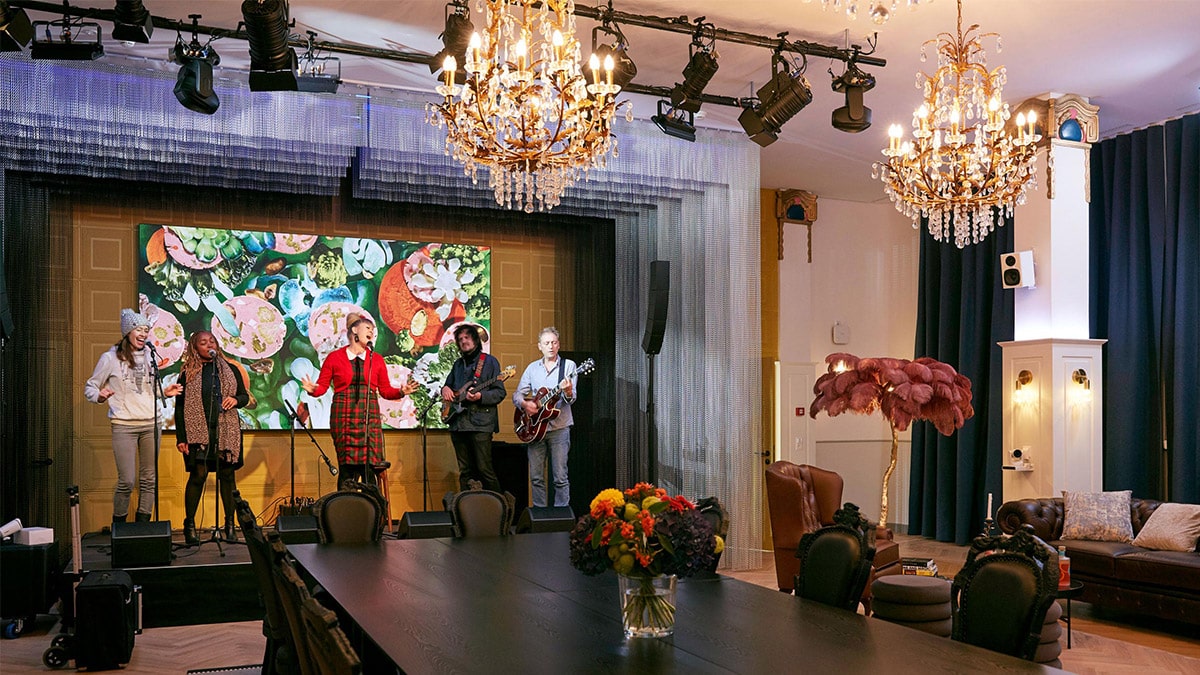RAPPERSWIL, Switzerland — Whatever you imagine a radio station to be, it probably won’t look at all like Radio Zürisee. The station sits in a historic hotel, complete with a ballroom and chandeliers, and the studio windows open to catch passing traffic. And that’s just the start.
When, in 1995, Radio Zürisee set out to look and sound different than the other 43 radio stations in Switzerland, it found that and a whole lot more in a 160-year-old hotel in the middle of Rapperswil, a picturesque town that juts into the east side of Lake Zürich. The hotel had a large ballroom, high ceilings with chandeliers and an interesting personality that proved to be an ideal home for a different kind of radio station combining live performers, homespun talk and an eclectic format.
When the station moved into the hotel, it walled off the ballroom into studios. Then, starting in 2017, the station decided to capitalize on the space. It opened up the ballroom and put in a professional stage for local performers. The station also added a kitchen and living room with group seating areas for presenters and guests and networked the entire facility using WheatNet-IP audio and remote control from Wheatstone.
At almost 200 square meters, the ballroom — now known as The Loft — is where all the action happens, on and off the air. In addition to regular broadcasts from The Loft, Radio Zürisee brings in local performers and rents out space for corporate events and other gatherings.
Roaming presenters
Whereas most radio stations prefer their presenters to remain within a studio, Radio Zürisee encourages its talent to roam freely about The Loft during their on-air shift. They’re allowed to make coffee, play pinball and engage their guests in baking, exercising or jamming, all while on the air. The main on-air studio — Studio 1 — looks onto this area and houses WheatNet-IP audio networked LXE console surfaces and modules for recording quick voiceovers, live news broadcasts and call-in programs.
“We had a heck of a time training the presenters so that they would leave the studio and go out into The Loft, but once they got the hang of it, they were all in,” said Mario Göldi, senior chief engineer for Radio Zürisee.
The presenters wear wireless mics and manage their shows via Windows Surface Pro tablets, which control the station’s DABiS800 playout system. They use this for routing audio, turning on mics, setting mix menus and managing other set and studio elements while in The Loft. DABiS800 and WheatNet-IP are fully integrated as a complete AoIP and automation/playout system using Wheatstone’s ACI protocol and logic I/O system.
Presenters use any of the two Radio Zürisee studios to produce content on LXE console surfaces, which they control with the same tablets they carry while on-air. Both studios are designed around a one-screen concept.
The large 49-inch screen in the center replaces several monitors, and is divided into workflow sections.
All the essential functions on the master module are programmed for instantaneous studio switchovers, selecting monitors, controlling LCD screens in The Loft and moving the motorized studio table or the PC monitors up or down.
Throughout The Loft is an interesting mix of eclectic, vintage and modern. For example, on one wall, beneath the ballroom chandeliers, is a large LCD screen for monitoring signal levels, routing and mixing.
Ready for visual radio
Within the kitchen area is an espresso machine the station has mic’d up, so that as presenters brew a cup, their listeners can listen in and be part of the experience. The kitchen blender and arcade game are also mic’d up, as are the windows for outside traffic sounds. In total, 32 elements are mic’d and normalized for level and dynamics using four Aura8-IP mic processors linked to the WheatNet-IP audio network.
The Loft also commands a sophisticated automated camera operating system. Radio Zürisee hired a professional cameraman from a local television station to place the cameras throughout so the station could switch back and forth between them. The MultiCAM camera automation is integrated into the IP audio network. Presenters can trigger the camera nearest to wherever they are in The Loft by pressing an icon on their tablet.
All this befits the station’s brand. The private station plays an eclectic mix of music for all demographics, and continues to rank in the top three in its market. Since redesigning the studios and opening up The Loft, Radio Zürisee has seen a significant jump in its audience. In character and setting, Radio Zürisee is definitely not your typical radio station.
Radio Zürisee studio project at a glance
Broadcast technology at the facilities comprises two 15-fader Wheatstone LXE console surfaces, 14 WheatNet-IP audio network BLADEs, a 24-channel SwitchBlade, 22 screens made with ScreenBuilder app and 24 AoIP drivers with floating licenses in Virtual Desktop Infrastructure environment (VDI).
The station recently added a Wheatstone Streaming Blade to replace its software-based streaming encoders. The three-input-channel system features built-in clip-player and redundant PSU. It also uses the Streaming Blade’s processor output to feed the DAB+ transmitt- ing encoder.
In addition, the studios make use of an IP-based KVM extender system feeding one 49-inch-curved monitor with a selection of up to 16 PC screens plus special studio keyboard with touch screen from WEY Technology AG in Switzerland.
The station uses the DABiS800 playout system from Swiss-based by DANEXiS and nine SDI cameras and custom-control software from France-based MultiCAM systems implementing an ACI to WheatNet-IP audio network.
The author is owner of Zürich-based Media Engineering.

